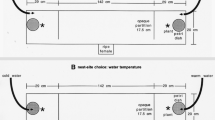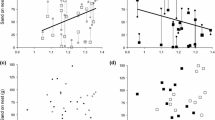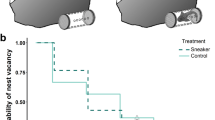Summary
In some species of fishes with paternal care, females prefer to spawn with males who are already defeding eggs; moreover, in many species, paternal care increases with the number of eggs that a male is defending. If egg survival depends on the level of paternal care, and is largely independent of egg number, then egg survival should increase with clutch size. This result would provide a potential adaptive mechanism for female preference for males with eggs. I examined the effects of clutch size on paternal care and egg survival in the fathead minnow, Pimephales promelas, and found that both increased with male clutch size.
Similar content being viewed by others
References
Assem J, van den (1967) Territory in the three-spined stickleback, Gasterosteus aculeatus L., an experimental study in intra-specific aggression. Behaviour (Suppl) 16:1–164
Carlisle TR (1982) Brood success in variable environments: implications for parental care allocation. Anim Behav 30:824–836
Coleman RM, Gross MR, Sargent RC (1985) Parental investment decision rules: a test in bluegill sunfish. Behav Ecol Sociobiol 18:59–66
Constanz GD (1985) Allopaternal care in the tessellated darter, Etheostoma olmstedi (Pisces: Percidae). Environ Biol Fishes 14:175–183
DeMartini EE (1987) Paternal defence, cannibalism and polygamy: factors influencing the reproductive success of the painted greenling (Pisces, Hexagrammidae). Anim Behav 35:1145–1158
Hamilton WD (1971) Geometry for the selfish herd. J Theor Biol 31:295–311
Iersel JJA van (1953) An analysis of parental behavior of the three-spined stickleback (Gasterosteus aculeatus L.). Behaviour (Suppl) 3:1–156
Isaak D (1961) The ecological life history of the fathead minnow, Pimephales promelas (Rafinesque). PhD Dissertation, University of Minnesota
Marconato A, Bisazza A (1986) Males whose nests contain eggs are preferred by female Cottus gobio L. (Pisces, Cottidae). Anim Behav 34:1580–1582
Pressley PH (1976) Parental investment in the threespine stickleback, Gasterosteus aculeatus. MSc Thesis, University of British Columbia
Pressley PH (1981) Parental effort and evolution of nest-guarding tactics in the threespine stickleback, Gasterosteus aculeatus L. Evolution 35:282–295
Ridgway MS (1986) Factors governing patterns of brood defense in male smallmouth bass (Micropterus dolomieui). PhD Dissertation, University of Western Ontario
Ridley M, Rechten C (1981) Female sticklebacks prefer to spawn with males whose nests contain eggs. Behaviour 76:152–161
Rohwer S (1978) Parental cannibalism of offspring and egg raiding as a courtship strategy. Am Nat 112:429–440
Sargent RC (1985) Territoriality and reproductive tradeoffs in the threespine stickleback, Gasterosteus aculeatus. Behaviour 93:217–226
Sargent RC, Gebler JB (1980) Effects of nest site concealment on hatching success, reproductive success, and paternal behavior of the threespine stickleback, Gasterosteus aculeatus. Behav Ecol Sociobiol 7:137–142
Sargent RC, Gross MR (1985) Parental investment decision rules and the Concorde fallacy. Behav Ecol Sociobiol 17:43–45
Sargent RC, Gross MR (1986) Williams' principle: an explanation of parental care in teleost fishes. In: Pitcher TJ (ed) The behaviour of teleost fishes. Croom Helm Beckenham, pp 275–293
Sokal RR, Rohlf FJ (1981) Biometry: The principles and practice of statistics in biological research, 2nd edn. Freeman, San Francisco
Trivers RL (1972) Parental investment and sexual selection. In: Campbell B (ed) Sexual selection and the descent of Man 1871–1971, Aldine, Los Angeles, pp 136–179
Unger LM (1983) Nest defense by deceit in the fathead minnow, Pimephales promelas. Behav Ecol Sociobiol 13:125–130
Unger LM, Sargent RC (1988) Allopaternal care in the fathead minnow, Pimephales promelas: females prefer males with eggs. Behav Ecol Sociobiol 23:27–32
Williams GC (1966) Natural selection, costs of reproduction and a refinement of Lack's principle. Am Nat 100:687–690
Author information
Authors and Affiliations
Rights and permissions
About this article
Cite this article
Sargent, R.C. Paternal care and egg survival both increase with clutch size in the fathead minnow, Pimephales promelas . Behav Ecol Sociobiol 23, 33–37 (1988). https://doi.org/10.1007/BF00303055
Received:
Accepted:
Issue Date:
DOI: https://doi.org/10.1007/BF00303055




